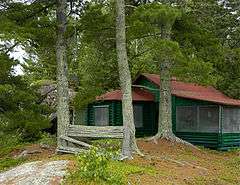Jun Fujita Cabin
|
Jun Fujita Cabin | |
|
The Jun Fujita Cabin from the east | |
  | |
| Nearest city | Ranier, Minnesota |
|---|---|
| Coordinates | 48°32′59″N 92°52′11″W / 48.54972°N 92.86972°WCoordinates: 48°32′59″N 92°52′11″W / 48.54972°N 92.86972°W |
| Area | 4 acres (1.6 ha) |
| Built | 1928 |
| Architect | Fujita, Jun |
| Architectural style | single pen cabin |
| NRHP Reference # | 96001351[1] |
| Added to NRHP | December 2, 1996 |
The Jun Fujita Cabin is a cabin in Saint Louis County, Minnesota, United States, now within Voyageurs National Park. It was built by Jun Fujita, a photographer and poet who spent a long career in Chicago. The cabin was listed on the National Register of Historic Places in 1996.[2]
Fujita was born in Hiroshima in 1888 and immigrated to Canada as a teenager. He spent a time as a photographer for a Japanese publication, then moved to Chicago and started working for the Chicago Evening Post, which later became the Chicago Daily News. His photography career included the 1915 sinking of the SS Eastland, the Chicago Race Riot of 1919, and the 1929 Saint Valentine's Day Massacre. In the 1930s, he left news photography and established a commercial photo studio on Harper Street. Some of his clients included Johnson Outboards, Stark Nurseries, and Sears, Roebuck and Co. Fujita completed some of his photography for Johnson on Rainy Lake on the border of the United States and Canada.[2]
Fujita's long-term companion, Florence Carr, bought a 4 acres (1.6 ha) island on Rainy Lake around 1928. Carr and Fujita met each other and began living together in the early or mid-1920s, but did not marry until 1940 due to anti-miscegenation laws. The island was purchased in Carr's name because Minnesota state laws restricted land ownership by non-citizens. Despite her ownership of the island, neighbors never recalled meeting Carr and remember Fujita as the sole occupant of the island. The island was called "Jap Island" by locals, a rather overt ethnic slur. It is now known as Wendt Island.[2]
This area of Minnesota was evolving into a vacation spot around the time, having become accessible when railroads reached International Falls, Minnesota and adjoining Fort Frances, Ontario around 1908. Highways to the area were built from Duluth, Baudette, and Bemidji by 1922. The area was still rather remote, since Duluth, the nearest large town, was 150 miles (240 km) away. The Rainy Lake area was popular with visitors who wanted to fish, hunt, or simply enjoy the wilderness. Some less-reputable recreational pursuits were also enjoyed by the locals, such as gambling, moonshine, prostitution, and other vice. The authorities of International Falls, Rainier, and Kettle Falls apparently tolerated this vice, though it started tailing off during the 1930s.[3]
Fujita started building his cabin with a 13 feet (4.0 m) by 16 feet (4.9 m) structure framed with cedar poles and covered in drop siding. He later added a screened porch with a shed roof on the north side, as well as a log addition measuring 7 feet (2.1 m) by 8 feet (2.4 m) on the east side. The floor in that room is slightly higher than the rest of the cabin, suggesting that it could have been a shrine. The cabin fits well into its surroundings of large rocks, pine trees, and wildflowers. Some of the architectural design reflects Japanese construction practices, such as modest decoration and a foundation of dry-laid stones.[2]
Although he still had privacy on the island, during the time of World War II he gradually stopped visiting the island. This could have been because of its distance from Chicago and the anti-Japanese prejudices during the war.[2] He allowed Fred and Edythe Sackett, owners of a nearby island, to use his cabin from the early 1940s, although he did not sell the cabin to them until 1956. The Sacketts added a bedroom on the south side and added some propane-powered appliances. In 1973, the Sacketts sold the property to Charles and Mary Jane Wendt, their friends from the Rapid City, South Dakota area. In 1985, the cabin and land were acquired by Voyageurs National Park, although the Wendts still lease the cabin.[3]
References
- ↑ National Park Service (2010-07-09). "National Register Information System". National Register of Historic Places. National Park Service.
- 1 2 3 4 5 Gardner, Denis P. (2004). Minnesota Treasures: Stories Behind the State's Historic Places. St. Paul, Minnesota: Minnesota Historical Society. pp. 273–276. ISBN 0-87351-471-8.
- 1 2 John Hurley (August 15, 1994). "National Register of Historic Places Nomination Form: Jun Fujita Cabin" (PDF). Retrieved 2013-03-29.
